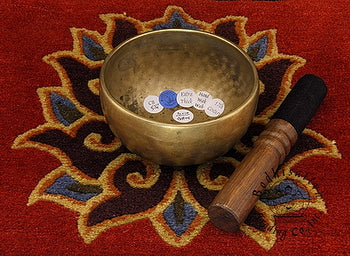
Using a Singing Bowl in Psychiatric Practice
Share
April 20, 2012 - by Shakti
As part of our Guest Series, I’m delighted to share my conversation with Rona C, a psychiatrist from Feasterville, PA and a recent customer of Bodhisattva. She was kind enough to discuss how she uses a Tibetan singing bowl in her work.Tell us about your practice.
I am an outpatient psychiatrist in private practice in Feasterville, PA. I graduated from Duke Medical School in North Carolina and did my residency at Hahnemann University in Philadelphia PA. I am board certified in psychiatry with added certification in geriatric psychiatry. I have been in private practice for 24 years and see many patients suffering with anxiety and depression.
Do you think there has been an increase in the amount of cases you’re seeing for these disorders?
There seems to be an increase in the number of people suffering from these disorders. I believe this is partly due to the increasing stress and distortion in our world. Technology, which is so rapidly evolving, and while offering so many benefits has contributed greatly to this stress. Our daily lives and the expectations placed on us are straining our biology which has taken millenia to evolve. Our bodies evolved in synchrony with the rhythms of nature, the yearly, seasonal, and circadian to name a few. Technology has made honoring these rhythms more irrelevant to our lives. This puts a strain on our bodies, minds and spirits and diseases such as depression and anxiety are triggered.
Humans evolved as social animals who are influenced by and benefit from human contact on a physical and chemical (ie pheromone) level. For instance, it is well documented that women living in close quarters become synchronized in their menstrual cycles. We are deprived of this with the increase of long distance and virtual interactions. It has been stated that thoughts and emotions have electromagnetic properties which can not be communicated as completely with this type of interaction. This attenuation in the intensity of the biological and electromagnetic communication contribute to a loss of grounding, a disconnection, a sense of isolation all which contribute to the rise of depression and anxiety.
It has been stated that abnormal reactions are normal in abnormal circumstances so perhaps this epidemic of anxiety and depression is in fact a normal result of the present world.
How are you using the bowl in your practice?
The bowls have a calming soothing effect on my patients. Their beautiful song seems to resonate with and calm the nervous system in a sweet, non intrusive and nonthreatening way. This morning I saw a woman with dental pain radiating to her face and neck. When I played the bowl for her, she said that it seemed to quiet the nerves. People who are so anxious that even relaxation techniques escalate their stress can experience relief with the bowl.
Do you think this is a result of brainwave entrainment, or are there other factors?
Modern physics is teaches us that all matter in our bodies is composed of vibrating waves. I believe that the singing bowl helps to entrain the vibrations into a cohesive concordant as opposed to discordant pattern. I believe the brainwaves are also entrained and this then further enhances the entrainment of the rest of the body.
How do you use the bowl in a session?
I am still learning about the many ways to use the bowl in a therapeutic manner. I will never use it without first asking the patient’s permission. I’ll tell a patient “I’d like to play this bowl for you, I think it’s going to be very calming. So sit back, try to relax, close your eyes and let it envelop you.” I instruct them to tell me if they need me to stop playing the bowl at any point. That has not happened yet though. I also play the bowl between sessions to refuel and relax.
And what reactions are you getting?
People generally become more relaxed, sometimes they tap in to deep emotions. I played it for someone who was telling me about her 16 year old dog who was dying. I played while she was talking, it seemed to help her connect more powerfully with the deep wells of emotion in her heart.
Do you feel that there is a potential for a lasting effect?
I do. The two minutes that I am able to play for my patients in my current practice format produces a temporary reprieve. It’s like changing the channel from stress to contentment. But I feel a paradigm in which I have a set of healing bowls which could be played for a prolonged period could cause lasting healing.
Do you sense a potential for vibrational therapy to be used as an adjunct therapy in a clinical setting? Would you consider prescribing a patient vibrational therapy as opposed to medication in certain circumstances?
I do feel there is great potential for adjunct use of vibrational therapy in a clinical setting and I hope to incorporate this into my own practice. For certain patients such as those who cannot tolerate, have had a poor response to or prefer a holistic approach to that of a pharmaceutical approach, vibrational therapy is an intriguing alternative.

